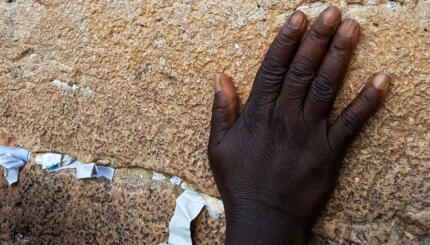The wedding band, exchanged under the chuppah (marriage canopy) and worn daily ever after, is an iconic part of a Jewish wedding. But did you know that Jews did not historically marry with rings? And that Jewish wedding rings might look different from other wedding rings?
Are you planning a Jewish wedding? Let us help out! Sign up for Breaking the Glass, an email series that will help guide you to the wedding that’s right for you!
History
Exchanging rings was not originally an essential part of Jewish marriage. There is, for example, no mention of a wedding ring in the Bible. Rather, the exchange of wedding rings is a custom Jews have absorbed from the wider cultures in which they have lived. Even so, it has now become an integral and iconic part of a Jewish wedding.
According to the Mishnah (Kiddushin 1:1), which also never mentions wedding rings (and neither does the Talmud), a man betroths a woman in one of three ways:
- Giving her money (a bride price).
- Giving her a written contract (shtar tena’im).
- Consummating the relationship.
Any one of these is sufficient, though the rabbis of the Talmud opposed the third method of betrothal and preferred the first — money.
The wedding ring, which came into use in Jewish circles probably in the medieval period, carries a certain minimal monetary value which means it can be used for the bride price. By giving his beloved a ring, the husband effectively gives her the monetary sum required to make her his bride. Historically, a husband could equally have given her anything else of monetary value, from a book to a property deed to a coin.
The amount required is quite small, making marriage available to people from all economic backgrounds. According to the Mishnah, a single perutah, the smallest denomination of ancient coinage, is sufficient. Jewish wedding rings need not be expensive.
When the groom gives the bride money or a ring, he is not buying her (a common misconception). The bride does not belong to him, nor is she his slave. Rather, what the groom is “buying” is exclusive intimacy with her. In other words, by accepting the ring (or money, or other item of value), the bride agrees that, from that point forward, she will not have intimate relations with anyone other than her groom.
Presenting the Ring
During the ceremony, the groom places the ring on the right index finger of the bride with the following declaration: harei at mekudeshet li b’taba’at zo k’da’at moshe v’yisrael. “Behold, with this ring, you are consecrated to me according to the law of Moses and Israel.”
Because it is now customary in the West to wear one’s wedding band on the left ring finger and not the right index finger, many people move the ring after the wedding ceremony.
As many streams of Judaism have become more egalitarian and started accepting gay and lesbian marriages, many Jews have opted for a double-ring ceremony in which each partner gives the other a ring and thereby the couple pledges mutual sexual fidelity. For rings given to a male partner, the language is as follows: harei ata mekudesh li b’taba’at zo kda’at moshe v’yisrael.
Selecting a Ring
There is a tradition that the Jewish wedding band should be a simple metal circlet with no gemstones or other embellishments.
Usually, the ring is made of gold which carries monetary value and does not tarnish or attract dirt — a hope that the marriage too will be lasting and beautiful. Sometimes, a connection is drawn to the rings of gold mentioned as part of the Tabernacle in Exodus 26:29. There is also a tradition that the ring be made of silver, a common metal for money.
Why do Jews usually choose rings with no adornment? One reason given is that the value of the ring should be apparent — so there is no deception or misunderstanding at the outset of the marriage. Others have argued that the simple ring represents hope for a similar honesty and purity in the relationship between the married partners. Some see the circle as a symbol of the equality of all people, including these two marriage partners. Still others argue that, as the ancient Greeks had it, the circle is the most perfect of all shapes, even as it hides within it an irrational ratio (pi). In this way, the circle of the ring represents a hope for a beautiful, perfect marriage even though it is contracted by two people who are only human and sometimes, like all of us, a bit irrational.



